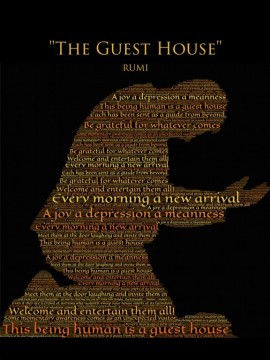
As we dive into another LifeForce Yoga Practitioner Training here in Tucson, welcoming all that arises, I am reminded of Rumi’s poem The Guest House, that so clearly reflects the foundation of a truth in all spiritual traditions. In the fear of the other that current global issues, like the immigration crisis in Syria and the state of American politics, are fostering, this 13th century Sufi Mystic’s poem is a balm:
This being human is a guest house.
Every morning a new arrival.A joy, a depression, a meanness,
some momentary awareness comes
as an unexpected visitor.Welcome and entertain them all!
Even if they are a crowd of sorrows,
who violently sweep your house
empty of its furniture,
still, treat each guest honorably.
He may be clearing you out
for some new delight.The dark thought, the shame, the malice.
meet them at the door laughing and invite them in.Be grateful for whatever comes.
because each has been sent
as a guide from beyond.— Jellaludin Rumi, translation by Coleman Barks
In this issue, we review three new books, one which is destined to be a classic on pranayama practice and yoga philosophy, another lovely treatise on Yoga and Grief, written from the perspective of a yoga therapist who has walked through the shadow of the loss of her child, and a new book, with plenty of practices and guidelines on using Yoga Nidra. We also report on two studies that show that yoga may be useful in the treatment of serious mental illness.
Research: More Studies Indicate Yoga May Benefit Schizophrenia
 In issue 65, we reported on a study from the prestigious Cochrane Review that, although more research is needed because the yoga studies were not on par with the rigor of better-funded pharmaceutical studies, found yoga may be as good or in perhaps some ways better than standard care for those suffering from schizophrenia.
In issue 65, we reported on a study from the prestigious Cochrane Review that, although more research is needed because the yoga studies were not on par with the rigor of better-funded pharmaceutical studies, found yoga may be as good or in perhaps some ways better than standard care for those suffering from schizophrenia.
Although the review is inconclusive, the authors found that “some positive evidence in favour (sic) of yoga over standard-care control,” which, they say, “should be interpreted cautiously.” This preliminary study helps lay the foundation for scientific validation of what we have been practicing and teaching. As the validation gets stronger, this means that more precious beings diagnosed with serious mental illnesses like schizophrenia will be seeking out and being referred to yoga classes, yoga ashrams and yoga centers.
Now another study strengthens these findings. A larger review of the literature on physical exercise that also includes yoga found that exercise is a robust add-on treatment for improving clinical symptoms, quality of life, global functioning, and depressive symptoms in patients with schizophrenia. The effect on cognition is not demonstrated, but, report the authors, “may be present for yoga.”
This makes it vital that yoga and mental health professionals take trainings like the LifeForce Yoga Practitioner Training and others designed to incorporate appropriate (often chair-based) yoga practices into mental health treatment. As people diagnosed with serious mental health conditions turn to yoga, it becomes vital that yoga and mental health professionals learn to collaborate with each other. It also means that spiritual centers need to be prepared for a population that may require more professional care than the traditional precautions and protocols regarding Kundalini awakening experiences.
Review: Pranayama: A Path to Healing and Freedom by Allison Gemmel LaFramboise
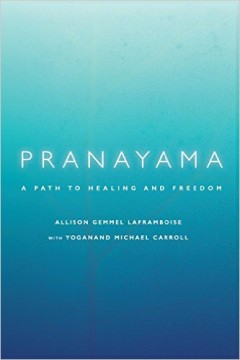 In this readable memoir-like, so-much-more-than-breathing practice manual, Allison LaFramboise tells the story of her own yoga journey that helped her clear away many life-long constrictions, especially after she began her studies with Yoganand Michael Carroll. Yoganand lived as a monk at Kripalu for fifteen years before becoming a married householder, and so brings the fire of intense sadhana practice into the secular world in which most of us live. The book is a collaboration and a weaving of the teachings and practices that LaFramboise learned from Yoganand, as seen and experienced and now taught by his student Allison. The story is both universal and unique. It includes Allison’s experience on retreat with Yoganand, where, along with other advanced practices and processes, participants spent hours practicing many of the pranayama offered in this book.
In this readable memoir-like, so-much-more-than-breathing practice manual, Allison LaFramboise tells the story of her own yoga journey that helped her clear away many life-long constrictions, especially after she began her studies with Yoganand Michael Carroll. Yoganand lived as a monk at Kripalu for fifteen years before becoming a married householder, and so brings the fire of intense sadhana practice into the secular world in which most of us live. The book is a collaboration and a weaving of the teachings and practices that LaFramboise learned from Yoganand, as seen and experienced and now taught by his student Allison. The story is both universal and unique. It includes Allison’s experience on retreat with Yoganand, where, along with other advanced practices and processes, participants spent hours practicing many of the pranayama offered in this book.
LaFramboise’s anecdotal approach engages the reader from the start. We want to know how Yoganand has translated these ancient practices for practitioners today. We want to know the practices that helped LaFramboise understand and transform the pain of rejection and early abuse. We want to know for ourselves the simple practice Swami Kripalu learned from his Guru and how Swami Kripalu and then Yoganand expanded those practices through textural study. Early on, we learn of Swami Kripalu’s mystical nature, and we are eager to follow the legend of his spontaneous discovery of both classic and self-realized pranayama practices to the practices Yoganand has adapted for practitioners today.
This thorough book covers the depth of yoga philosophy that will initiate the novice without overwhelming her or him, and yet will appeal to the life-long practitioner. Along with the many preparation practices and yoga breathing exercises, LaFramboise integrates mudras (hand gestures), cleansing practices, and postures, making recommendations in the Appendix about developing your daily practice and fully integrating yoga into your life.The photos of Yoganand are clear and, actually, pretty amazing, as they visually confirm the depth of his practice.
My only reservation in fully recommending this book is that I would advise caution to those with bi-polar disorder, post-traumatic stress disorder and high levels of anxiety. The preparatory practices, known as shatkriyas, along with many of the energizing pranayama and Kriya breathing practices, could exacerbate your condition. Most Western books about yoga, especially those written for yoga therapy, do not even include practices like Nauli and Bhasti. In the Kripalu tradition, as in many traditional yoga practices taught in India, the cleansing practices are most often done early in the morning to prepare the body for pranayama, so it is natural that the authors would put the section that includes these practices near the beginning of the book, before teaching pranayama. However, readers new to yoga, please be warned that this is not necessarily the way for you to begin. For some new students, such practices are fine, but they are not for everyone. The authors state this, but do not give it much emphasis. Do consult a well-trained yoga therapist if you have emotional imbalances that you think might be triggered by what many yogins consider advanced practices. Aside from this safety concern, this book will become, in my opinion, a modern classic. I was sent the PDF for review, and I can’t wait to get the hard copy in my hands!
Review: Yoga Nidra for Complete Relaxation and Stress Relief by Julie Lusk
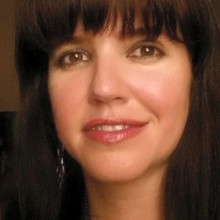 This book was reviewed by Rose Kress, ERYT-500, LFYP-2, LFY Educator. Rose began practicing yoga in 1994 and teaching since 2004. In that time she has focused on the therapeutic aspects of yoga – for the body, mind and soul. Rose teaches classes and workshops throughout the Tucson area. Rose integrates LifeForce Yoga techniques into therapeutic yoga for back pain, cancer, pulmonary disease, structural wellness, and yoga therapy. Rose is the Program Manager of the LifeForce Yoga Healing Institute and travels with Amy to assist her in LifeForce Yoga Practitioner Trainings.
This book was reviewed by Rose Kress, ERYT-500, LFYP-2, LFY Educator. Rose began practicing yoga in 1994 and teaching since 2004. In that time she has focused on the therapeutic aspects of yoga – for the body, mind and soul. Rose teaches classes and workshops throughout the Tucson area. Rose integrates LifeForce Yoga techniques into therapeutic yoga for back pain, cancer, pulmonary disease, structural wellness, and yoga therapy. Rose is the Program Manager of the LifeForce Yoga Healing Institute and travels with Amy to assist her in LifeForce Yoga Practitioner Trainings.
 Julie Lusk, a leader of relaxation retreats and guided imagery, pours her wisdom into Yoga Nidra for Complete Relaxation and Stress Relief. Yoga nidra, a key practice of LifeForce Yoga, combines the best of stress management, relaxation training, guided imagery and meditation (Lusk, 2). In her new book, Lusk shares an accessible review of the practice of yoga nidra, complete with research, anecdotes, scripts and downloadable audio.
Julie Lusk, a leader of relaxation retreats and guided imagery, pours her wisdom into Yoga Nidra for Complete Relaxation and Stress Relief. Yoga nidra, a key practice of LifeForce Yoga, combines the best of stress management, relaxation training, guided imagery and meditation (Lusk, 2). In her new book, Lusk shares an accessible review of the practice of yoga nidra, complete with research, anecdotes, scripts and downloadable audio.
Chapter one provides readers with an understanding of stress and the stress response. Lusk details the body’s physiological responses during the fight-flight-freeze and how these are counteracted by the relaxation response. We all experience stress, which Lusk defines as when an individual person perceives that the demand placed upon them is greater than personal coping skills and resources. Through assessing personal stress patterns by completing the questionnaire in Chapter 1, readers may discover that they are under more stress than they previously believed. The stress response is an automatic and unconscious pattern for which we are hardwired, so we need to learn ways to intervene as well as use skills to break the cycle of stress (35). Yoga Nidra is the perfect practice for training the mind to cope with stress.
In Chapter two, Lusk gives a deeper understanding of yoga nidra. As a practice, it is done lying down, while listening to a CD or a teacher. But this practice is more than simple relaxation. It offers a doorway into meditation through the practice of pratyahara (withdrawal, or turning in, of the senses), which, as Lusk says, is missing in many yoga and meditation practices. Our senses are becoming overloaded with electronics, loud noises, flashing colors, and scents leading to less awareness of our bodies, boundaries, and limitations. Controlling the senses, by focusing inwards, creates a greater awareness of our inner landscapes, giving insight to patterns of behavior, reaction, and stress. As this awareness grows, we become less reactive to stressors and sensory experiences…[and] to becoming increasingly more responsive (52).
We will always experience stress, that is until we identify with our true Self, the unchanging, witness consciousness that allows for an attitude of responding. In Chapter three, Lusk goes into greater detail of how to practice yoga nidra. There are many different styles of yoga nidra, but they have components in common. Sankalpa, the sacred vow that you make to yourself, is set at the beginning and end of yoga nidra, defined as the heart’s desire in LifeForce Yoga. It is set at the beginning and end of yoga nidra because the brain is most receptive to the positive affirmation that is sankalpa due to the change in brain waves during yoga nidra (66). This helps us to understand that yoga nidra is more than relaxation, or an invitation to meditation. It leads to growing the seeds of the heart’s desire. This is why Lusk encourages the establishment of a regular practice. She offers suggestions for deepening your practice, tips for handling distractions, and support of designing the practice that is right for you.
The final three chapters contain three different yoga nidra practices. The chapter begins with information about the practice and includes the script for that yoga nidra. The first is a yoga nidra for relaxation. The second is a yoga nidra for reflection, scanning the body and awareness of the chakras. The third is a yoga nidra for revitalization, exploring the opposites. All three yoga nidras are available as downloads through the publisher. Lusk concludes with an appendix of yoga mudras, hand gestures, to support the practice of yoga nidra. Through clear and easy language, Lusk provides insight to yoga nidra. If you don’t already have a daily yoga nidra practice, Lusk’s book is likely to inspire one!
Review: Yoga for Grief and Loss by Karla Helbert
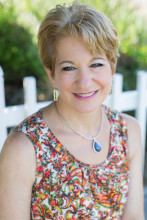 This book was reviewed by Rickie Simpson PhD PMHCNS-BC, BCPCC, LFYP-2/Mentor, E-RYT. Ricky is a Board Certified Psychiatric-Mental Health Clinical Nurse Specialist specializing in individual, couples, group and family therapy. She integrates complementary methodologies and techniques to offer a highly personalized faith-consistent approach tailored to each client. She belongs to the International Association of Practitioners of Encounter-centered Couples Therapy and maintains a board certification as a Professional Christian Counselor. She maintains a private practice in Manassas, Virginia and is on the faculty of Stratford University teaching Nursing Research and Psychiatric Nursing.
This book was reviewed by Rickie Simpson PhD PMHCNS-BC, BCPCC, LFYP-2/Mentor, E-RYT. Ricky is a Board Certified Psychiatric-Mental Health Clinical Nurse Specialist specializing in individual, couples, group and family therapy. She integrates complementary methodologies and techniques to offer a highly personalized faith-consistent approach tailored to each client. She belongs to the International Association of Practitioners of Encounter-centered Couples Therapy and maintains a board certification as a Professional Christian Counselor. She maintains a private practice in Manassas, Virginia and is on the faculty of Stratford University teaching Nursing Research and Psychiatric Nursing.
“Micah’s dead” in disbelief I listened to these anguished words over the phone as my distraught husband notified me that Pediatric Sudden Death Syndrome had snatched our healthy two-year old grandchild from us. He had been to the doctor just that morning and we were told that he was fit and fine. Four hours later he was dead. From that moment, our family fell headlong into the experience of being “in grief”. Nothing could have prepared us for the intensity of this life journey as we have mourned not only our grandchild but also our vivacious, joyous daughter as she claws her way back to the living.
 Reading Yoga for Grief and Loss by Karla Helbert felt like reading the diary of someone who has shared in the enormity of childhood death. Ms. Helbert, herself having experienced the death of her young son from cancer, sensitively captured the grief experience and the gift of yoga in multiple ways. One of the practices mentioned in her book on page 96 that is gentle and extremely effective in early grief is the use of Padma mudra over the heart center. Placing this simple mudra over the heart center helps to calm the mind from the stress of racing thoughts and stimulates the body’s ability to heal itself by balancing the immune system. Through these months, I too have found yoga a skiff in stormy seas and racing thoughts. Simple, effective mudras and breathing patterns that can be learned quickly and used often can be a life-line to the bereaved especially in those early, confusing months when the abilities to manage long meditations seem a lifetime ago.
Reading Yoga for Grief and Loss by Karla Helbert felt like reading the diary of someone who has shared in the enormity of childhood death. Ms. Helbert, herself having experienced the death of her young son from cancer, sensitively captured the grief experience and the gift of yoga in multiple ways. One of the practices mentioned in her book on page 96 that is gentle and extremely effective in early grief is the use of Padma mudra over the heart center. Placing this simple mudra over the heart center helps to calm the mind from the stress of racing thoughts and stimulates the body’s ability to heal itself by balancing the immune system. Through these months, I too have found yoga a skiff in stormy seas and racing thoughts. Simple, effective mudras and breathing patterns that can be learned quickly and used often can be a life-line to the bereaved especially in those early, confusing months when the abilities to manage long meditations seem a lifetime ago.
Helbert’s discussion regarding the yama (observance) of satya (truth) particularly resonated as my daughter and I have begun to develop a list of what NOT to say to people starting with “how are you’ followed closely by “what can I get you”or “how many children/grand children do you have?” These simple questions offered by well-meaning individuals require the mourner to live a dual-life. At the very moment I am least able to think clearly, do I speak my truth? In speaking my truth could I possibly cause you pain violating the yamas of Ahimsa or do I violate the yamas of Satya and say, “I have three grandchildren” and leave out the gritty truth which is “and one of them is dead.” Her recognition of the tension between the yamas and her suggestions for managing the duality of these tensions were extremely helpful and practical.
Ms. Helbert notes, “From tapas [will] to svadhyaya [self-study] to ishvara pranidhana [surrender], the process is a continuum. The pain and spiritual crisis of grief is ultimately about surrender.” This view seemed strikingly similar to the view of Kubler-Ross that grief is a continuum from denial to acceptance. A person on this path knows intimately and completely that our beloved and our past knowings are lost forever to this plane of existence. We must build anew without grasping. If I have learned anything this year it is that I will always be afraid as long as I hang on to anything this life has to offer. Letting go leads to fearless living.
One cautionary note: Early in the book, the practices offered might overwhelm those individuals who are new in their grief processes. An example of this is the practice called meditation: Grief in the now. The waves of grief she accurately describes in her book would benefit from the empathetic presence of another human being. It is enormously painful to be in grief but it is unbearable to be in grief alone. In later practices, she advises that those in deep grief to consider whether a trusted counselor or friend should accompany the person while practicing the offered meditation. Given the intensity of early grief, this option would have been useful to mention for all the practices.
Secondly, since the book is clearly in the tradition of Sri Swami Satchidananda from the Integral Yoga tradition, the handling of the subject matter regarding deities may be difficult for those individuals who carry a strong monotheistic viewpoint. Given these concerns, this book is an excellent book for yoga teachers and psychotherapist but should be given cautiously to someone who is early in their traumatic grief process or has a firm monotheistic worldview.
As a LifeForce Yoga® practitioner, the practices offered in this book greatly augment those taught by Amy Weintraub and could be seamlessly added during a LifeForce Yoga practice. Helbert presents the subtler yogic concepts such as the mudras, koshas, the different yogic paths, the yamas and niyamas in such a clear way that this book has great application as a yoga text for those new to yoga. It should be a “must read” for yoga teacher trainees from any tradition and a useful book for both yoga therapists and psychotherapist walking alongside the grief path with their clients.
News: 2016 Professional Training Opportunities
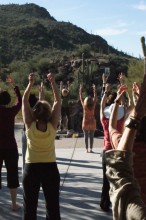 We are currently in Tucson, AZ holding the first LifeForce Yoga Practitioner Training of 2016! We have several additional professional training opportunities this spring and summer. These trainings are a once in a lifetime opportunity to train and learn directly from Amy Weintraub, LifeForce Yoga’s Founding Director and author of Yoga for Depression and Yoga Skills for Therapists and a pioneer for yoga and mental health. Each training is assisted by a faculty LifeForce Yoga Mentors who are trained as mental health and yoga professionals.
We are currently in Tucson, AZ holding the first LifeForce Yoga Practitioner Training of 2016! We have several additional professional training opportunities this spring and summer. These trainings are a once in a lifetime opportunity to train and learn directly from Amy Weintraub, LifeForce Yoga’s Founding Director and author of Yoga for Depression and Yoga Skills for Therapists and a pioneer for yoga and mental health. Each training is assisted by a faculty LifeForce Yoga Mentors who are trained as mental health and yoga professionals.
LifeForce Yoga Practitioner Training
Location: Yogaville – Buckingham, VA
Dates: April 3-10, 2016
Assisting Faculty: Rose Kress ERYT-500, LFYP-2, LFY Educator, Rickie Simpson, RYT, LFP-2, Ph.D.
Learn More
What are “Module A” Trainings?
We have created a 3-Part Practitioner Training Course to provide our certification for those who can not commit to the financial and time commitment of our traditional retreat style training. Module A is completed in person, Module B is completed online, and Module C is mentoring conducting by phone or Skype. To learn more about our Modular Training option click here.
LifeForce Yoga Practitioner Training Module A
Location: Sivananda Ashram – Paradise Island, Bahamas
Dates: March 28 – April 1, 2016
Assisting Faculty: Rose Kress, RYT-500, a LifeForce Yoga Educator and Mentor and a Functional Yoga Therapist; and Kathy Shafer PhD, LCSW, E-500RYT, a psychotherapist, educator and LifeForce Yoga Practitioner, nationally known for her work in addictions.
LifeForce Yoga Practitioner Training Module A
Location: Kripalu – Stockbridge, MA
Dates: July 3-8, 2016
Assisting Faculty: Rose Kress ERYT-500, LFYP-2, LFY Educator, Laura Orth, LICSW, LFYP-2, Kat Larsen, RYT-200, LFYP-2, Reiki Certified
Registration will open in February
Learn More
Yoga Skills for Therapists
Cape Cod Institute – Eastham, MA
Dates: July 25-29, 2015
Assisting Faculty: Sherry Rubin, LCSW, ERYT-200, LFYP-2
Learn More
Thanks for all the great information and keeping current on the resources and research. So helpful! Namaste.
Thank you, Colleen! I’m glad you find the newsletter of use. Amy